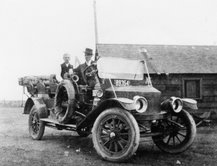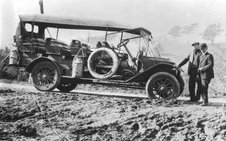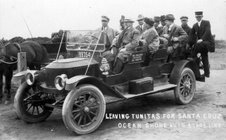Story by John Schmale
 [Image: During its first year of service: Ocean Shore Railroad-owned Stanley Steamer “Number One” awaits a southbound passenger train at the northern division railhead at Tunitas Creek. At Tunitas, passengers boarded the sporty steam car for a thrilling 26- mile run through the railless “Gap” to the Ocean Shore Railroad’s southern division railhead at Swanton. The 26- mile trip took five hours, with six scheduled stops. (Bob Gray photo: courtesy Rick Hamman.]
[Image: During its first year of service: Ocean Shore Railroad-owned Stanley Steamer “Number One” awaits a southbound passenger train at the northern division railhead at Tunitas Creek. At Tunitas, passengers boarded the sporty steam car for a thrilling 26- mile run through the railless “Gap” to the Ocean Shore Railroad’s southern division railhead at Swanton. The 26- mile trip took five hours, with six scheduled stops. (Bob Gray photo: courtesy Rick Hamman.]
Stanley Steamers of the Ocean Shore Railroad
By John Schmale
After 1900, electric railroad schemes surfaced in every part of California-some well conceived, some, ill conceived. Some were very successful-most were not. One sad story was that of the, ill fated, Ocean Shore Railway. Its backers were all very well known and wealthy San Franciscans.
The plan was to run a double track electric railroad, from San Francisco, along the Pacific Ocean, some 83 miles, to the seaside town of Santa Cruz-a town known for beautiful beaches and its redwood timber industry. The ultra-powerful Southern Pacific Railroad already served the town. Ocean Shore backers were certain that a fast electric line, offering beautiful ocean scenery and reduced running time could siphon off tourist and freight business from the SP.
Incorporated on May 18, 1905, the Ocean Shore Railway began construction at several key points along the line including Devils Slide and Mussel Rock bluffs. Much of the construction equipment and manpower was focused on blasting roadbed from near-vertical cliffs. In one place, a single charge containing 450 tons of black powder was exploded, tossing an entire mountaintop into the Pacific Ocean. For the next several months construction went as planned. The future couldn’t have looked brighter.
Early morning on April 18, 1906, the famous disaster that befell San Francisco did not spare the Ocean Shore Railway. At Mussel Rock Bluffs, earthquake shockwaves sent Ocean Shore’s steam shovel, and other equipment, crashing from a high cliff to the beach below. Several miles of twisted, broken, and sagging track would have to be rebuilt. Equipment in San Francisco suffered as well, but the most severe damage was done to bank accounts of the line’s directors. Their investments focused on San Francisco businesses and real estate. The financial panic that followed the earthquake and fire meant that plans to double-track the system would be shelved, and so would electrification. The exception was an electric-only portion of tracks in San Francisco required by city franchise. Steam locomotives ran over the rest of the line.
Construction resumed at a slow pace. By 1909, the northern-division had advanced southward, to Tunitas Creek, while construction on the south end pushed northward from Santa Cruz to Swanton, leaving a gap of 26 miles. A horse drawn stage line bridged this gap.
With state-funded road improvements beginning in 1913, the partially completed railroad had now to compete with private trucks, autos, and jitneys, that cut into the railroad’s traffic of sand, rock, vegetables, artichokes, picnic-trains, and a limited San Francisco commute business. All construction halted.
In an effort to offer swift through service from San Francisco to Santa Cruz, Ocean Shore Railroad’s, offshoot-corporation, the Ocean Shore Auto Stage Company, in March 1914, purchased a shinny, new, Stanley Steamer bus. It was a twelve-passenger, thirty-horsepower, Mountain Wagon.  [Image: Stanley Steamer “Number Two,” a 12-passenger Mountain Wagon with the top up, posed near a creek between Ocean Shore Railroad railheads. Milk cans tied to the running boards of the bus may have been full of trout for planting in local streams. Another explanation is the cans are simply full of water to feed the Stanley’s thirsty boiler. (Rudy Brandt Collection)
[Image: Stanley Steamer “Number Two,” a 12-passenger Mountain Wagon with the top up, posed near a creek between Ocean Shore Railroad railheads. Milk cans tied to the running boards of the bus may have been full of trout for planting in local streams. Another explanation is the cans are simply full of water to feed the Stanley’s thirsty boiler. (Rudy Brandt Collection)
The bus was placed in service on April 1, 1914. Two trains per day connected with the new auto stage line at Tunitas. Through-passengers boarded the southbound Stanley Steamer for the towns of San Gregorio, Pescadero, Pigeon Point, Gazos, and Waddell, connecting in Swanton with the southern-division trains to Santa Cruz. Northbound passengers boarded the buses in Swanton for the reverse trip.
Due to the popularity of the auto service, a second Stanley Mountain Wagon was delivered on June 10, 1914.  [Image: The popular Stanley Steamer headed for Swanton where passengers going to Santa Cruz boarded the Southbound Ocean Shore train. For the traveling public the steamers were a welcome relief from the stagecoaches they replaced. Bob Gray and Harry Staples ran the “Ocean Shore Auto Stage Company.” (John Schmale Collection.]
[Image: The popular Stanley Steamer headed for Swanton where passengers going to Santa Cruz boarded the Southbound Ocean Shore train. For the traveling public the steamers were a welcome relief from the stagecoaches they replaced. Bob Gray and Harry Staples ran the “Ocean Shore Auto Stage Company.” (John Schmale Collection.]
This proved to be a timely purchase, for the following two winters were wet, disastrous, and costly for the, already impoverished railroad. Heavy rains caused washouts and slides along miles of the cliff-hugging roadbed. The entire northern division was closed from January 15, 1915, through March 2, 1915. The two Stanley Steamers saved the day by ferrying passengers, mail, and express packages from Swanton and Tunitas over thirty-five miles of torturous, muddy, mountain roads to San Francisco. Their franchise allowed the steamers to run only between Ocean Shore railroad’s terminal at Tunitas and its Southern division terminal at Swanton. However, during this emergency operation the rules were overlooked.
This scenario was repeated the following year when the Railroad was again shut down. During the severe rainy winter of 1916 the steamers ran at full tilt, until one blew a boiler. The company had a new boiler expressed from Denver and the vehicle was down for less than a week. The stage company missed only one day of mail delivery.
The two Stanley Steamers continued to provide reliable daily service to Ocean Shore Railroad patrons until the permanent closure of the railroad on August 17, 1920.
Because the rail service ended suddenly, the steamers were again allowed to carry mail, passengers and light freight from stranded coast side communities into San Francisco. Former Ocean Shore Railroad employees, Jim Gray, and Harry Staples, who had operated the buses for the railroad, continued the same service on an emergency basis. On January 14, 1921, the California State Railroad Commission granted them a permanent license. It is not known when the bus service ended or what became of the two Stanley Steamers. Research is ongoing.
==========
Railroad historians John and Kristina Schmale’s new book is called The Petaluma and Santa Rosa Railway, published by Arcadia. The authors will be signing books at Copperfield’s Bookstore in Petaluma. For more info, please call 707-762-0563 or email Grace Bogart: [email protected]
